Lateral Transfer Letter
[Your Name]
[Your Address]
[City, State, ZIP Code]
[Email Address]
[Phone Number]
[Date]
[Recipient's Name]
[Recipient's Designation]
[Department/Division Name]
[Company/Organization Name]
[Company/Organization Address]
[City, State, ZIP Code]
Subject: Lateral Transfer Request
Dear [Recipient's Name],
I hope this letter finds you well. I am writing to formally request a lateral transfer within [Company/Organization Name] from my current position as [Your Current Position] in the [Current Department/Division] to a similar position in the [Desired Department/Division]. I believe that this transfer will not only benefit my professional growth but also contribute to the overall success of the organization.
Over the past [duration] that I have been with [Company/Organization Name], I have had the privilege of working in various capacities within the [Current Department/Division]. While I have gained valuable experience and skills during this time, I am eager to explore new challenges and contribute my expertise to the [Desired Department/Division].
I have thoroughly researched the responsibilities and goals of the [Desired Department/Division] and I am confident that my skill set and passion align well with the objectives of the team. Through this lateral move, I hope to bring my [mention specific skills or experiences that are relevant] to the table, which I believe will enhance the department's ability to achieve its targets.
I have discussed my intentions with my current supervisor, [Current Supervisor's Name], and they have expressed their support for my decision to pursue this transfer. I am fully committed to ensuring a smooth transition and completing any necessary tasks or projects to facilitate this process.
I understand that my request for a lateral transfer will be subject to approval based on the needs of both departments and the organization as a whole. I am willing to work closely with the HR department and the concerned managers to ensure a seamless transition if my request is granted.
I kindly request an opportunity to discuss this transfer request further in person. Please let me know a convenient time for you, and I will be more than willing to accommodate your schedule.
Thank you for considering my request. I am excited about the possibility of contributing to the success of the [Desired Department/Division] and continuing my journey with [Company/Organization Name].
Sincerely,
[Your Signature]
[Your Typed Name]
Enclosure: [If applicable, list any documents attached, such as a current resume or additional information]
Internal Lateral Transfer Request - Professional
Subject: Request for Lateral Transfer to [Department/Position Name]
Dear [Manager's Name/HR Director's Name],
I am writing to formally request a lateral transfer from my current position as [Current Position] in the [Current Department] to the [Desired Position] role in the [Desired Department]. I have been with [Company Name] for [duration] and believe this move would allow me to contribute more effectively to the organization while advancing my professional development.
During my tenure in [Current Department], I have gained valuable experience in [key skills/responsibilities]. The opportunity to transition to [Desired Department] aligns with my career goals and would enable me to leverage my expertise in [relevant skills] while developing new competencies in [areas of growth].
I have discussed this potential move with [Supervisor's Name], who is supportive of my career development goals. I am committed to ensuring a smooth transition and would be happy to assist in training my replacement or documenting processes to minimize disruption to ongoing projects.
I am available to discuss this request at your earliest convenience and would appreciate the opportunity to explore how this transfer could benefit both my professional growth and the organization's objectives.
Thank you for considering my request. I look forward to your response.
Sincerely,
[Your Name]
[Current Position]
[Contact Information]
Lateral Transfer Due to Relocation - Formal
Subject: Lateral Transfer Request Due to Relocation
Dear [HR Manager's Name],
I am writing to request a lateral transfer to [Branch/Office Location] due to my upcoming relocation to [City/State]. My family and I will be moving to this area on [approximate date] due to [spouse's job transfer/family circumstances/personal reasons].
I have thoroughly enjoyed my role as [Current Position] and am eager to continue contributing to [Company Name] in a similar capacity at the [Location] office. I have researched available positions and believe the [Position Title] role would be an excellent fit for my skills and experience.
My current responsibilities include [list key responsibilities], and I am confident I can seamlessly transition these skills to support the team at [new location]. I have [X years] of experience with the company and am fully committed to maintaining the same level of performance and dedication in the new location.
I would appreciate the opportunity to discuss available positions and the transfer process. I am flexible regarding start dates and am willing to coordinate with both my current and prospective teams to ensure continuity.
Please let me know the next steps in this process. I am happy to provide any additional information or documentation needed to facilitate this transfer.
Respectfully,
[Your Name]
[Employee ID]
[Contact Information]
Lateral Transfer for Career Development - Heartfelt
Subject: Request for Career Development Transfer
Dear [Manager's Name],
I hope this message finds you well. I am reaching out to discuss an opportunity that I believe would be beneficial for both my professional growth and our organization's success.
Over the past [time period], I have developed a deep passion for [area/field], and I have come to realize that my strengths and interests align more closely with the work being done in [Department Name]. While I have valued every moment in my current role and am grateful for the skills I've developed here, I feel called to pursue this new direction.
The [Position Title] role in [Department] represents exactly the kind of challenge I'm looking for at this stage in my career. I believe my background in [current expertise] combined with my enthusiasm for [new area] would allow me to make meaningful contributions to that team.
I want to emphasize that this request comes from a place of wanting to grow within our organization, not from any dissatisfaction with my current position or team. I have the utmost respect for everyone I work with and would ensure a thoughtful transition that honors my commitments here.
I would be grateful for the opportunity to discuss this with you further. Your guidance has been invaluable to me, and I hope you'll support me in taking this next step.
With sincere appreciation,
[Your Name]
Lateral Transfer to Avoid Layoff/Department Closure - Serious
Subject: Lateral Transfer Request - [Current Department] Restructuring
Dear [HR Director's Name],
In light of the recent announcement regarding the restructuring of [Department Name], I am writing to formally request consideration for a lateral transfer to another department within the organization.
I have been a dedicated employee of [Company Name] for [duration], consistently meeting or exceeding performance expectations. My performance reviews reflect my commitment to excellence, and I have successfully [mention key achievements].
Given my experience in [skills/areas], I believe I would be a strong fit for positions in [Department 1], [Department 2], or [Department 3]. Specifically, I am interested in roles such as [Position Types] where I can apply my expertise in [relevant skills].
I understand the organization is navigating significant changes, and I want to be part of the solution. I am flexible, adaptable, and ready to learn new systems and processes to contribute effectively in a new capacity.
I am requesting a meeting to discuss available opportunities and how my skills might best serve the company's current needs. I am prepared to begin this transition as soon as appropriate and will work diligently to minimize any disruption during the change.
Thank you for your consideration during this challenging time. I remain committed to [Company Name] and hopeful about continuing my career here.
Sincerely,
[Your Name]
[Current Position/Department]
[Employee ID]
Lateral Transfer for Health/Accommodation Reasons - Formal
Subject: Request for Lateral Transfer - Medical Accommodation
Dear [HR Manager's Name],
I am writing to request a lateral transfer to a position that better accommodates my current medical situation. As documented with [HR/Occupational Health], I have been experiencing [general description of condition] that makes certain aspects of my current role challenging.
After consulting with my healthcare provider and reviewing the ADA accommodation process, I believe a lateral transfer to [Position Type] in [Department] would allow me to continue contributing effectively while managing my health needs. This type of role would provide [specific accommodations needed: reduced physical demands/flexible scheduling/remote work options/etc.].
I want to emphasize my commitment to [Company Name] and my desire to continue my employment in a capacity that works for both my health requirements and the organization's needs. I have attached documentation from my healthcare provider outlining the recommended accommodations.
I am confident that I can perform excellently in roles that [describe suitable work conditions], and I am eager to discuss how we can make this transition successful. My skills in [relevant abilities] remain strong, and I am prepared to undergo any necessary training for a new position.
I would appreciate the opportunity to meet with you and discuss available options that might be suitable. Please let me know what additional information or documentation you need from me to move forward with this request.
Thank you for your understanding and support.
Respectfully,
[Your Name]
[Current Position]
[Contact Information]
Lateral Transfer to Resolve Workplace Conflict - Professional
Subject: Lateral Transfer Request
Dear [HR Manager's Name],
I am writing to request a lateral transfer to another team or department within [Company Name]. After careful consideration, I believe this move would be in the best interest of both my professional effectiveness and the overall productivity of my current team.
Despite my efforts to address challenges in my current work environment, I have found it increasingly difficult to perform at my highest level. I believe a fresh start in a different team would allow me to refocus on delivering quality work without the interpersonal complications that have emerged.
I want to be clear that I remain fully committed to [Company Name] and have no desire to leave the organization. My work performance and dedication to company goals have not changed, and I am confident that in a different setting, I can continue to contribute meaningfully to our collective success.
I am open to positions in [Department 1], [Department 2], or similar areas where my skills in [relevant abilities] would be valuable. I am flexible regarding specific roles and am willing to take on new responsibilities as needed.
I would appreciate a confidential discussion about available opportunities and the process for making this transition as smooth as possible. I am committed to maintaining professionalism throughout any transition period.
Thank you for your consideration and discretion in this matter.
Sincerely,
[Your Name]
[Current Position]
Lateral Transfer Acceptance Email - Professional
Subject: Acceptance of Lateral Transfer to [New Position]
Dear [Manager's Name/HR Manager's Name],
I am writing to formally accept the lateral transfer to the position of [New Position Title] in the [New Department], effective [Start Date]. I am excited about this opportunity and grateful for the confidence the organization has shown in me.
I want to express my appreciation to my current team in [Current Department] for the support and knowledge they have provided during my time here. I am committed to ensuring a smooth transition and will work closely with [Current Manager's Name] to document processes and assist in training my successor.
I am looking forward to joining the [New Department] team and contributing to [specific goals or projects]. I am confident that my experience in [relevant areas] will enable me to add value quickly while I learn the nuances of this new role.
Please let me know if there are any forms, orientations, or preparatory steps I should complete before my official start date. I am eager to begin this new chapter and appreciate everyone's support in making this transition possible.
Thank you once again for this opportunity.
Best regards,
[Your Name]
[Current Position]
[Contact Information]
Manager Supporting Employee's Lateral Transfer - Formal
Subject: Recommendation for [Employee Name]'s Lateral Transfer
Dear [Receiving Manager's Name/HR Director's Name],
I am writing to express my full support for [Employee Name]'s request for a lateral transfer to [Position Title] in your department. While I will be sorry to see [him/her/them] leave our team, I believe this move represents an excellent opportunity for [Employee Name]'s professional development and will benefit the organization.
During [his/her/their] time in [Current Department], [Employee Name] has consistently demonstrated [key strengths and qualities]. [He/She/They] has been instrumental in [specific achievements or projects], and [his/her/their] contributions have significantly impacted our team's success.
I believe [Employee Name]'s skills in [relevant abilities] make [him/her/them] particularly well-suited for the challenges and opportunities in your department. [His/Her/Their] ability to [specific skill] and track record of [achievement type] will serve your team well.
I am committed to facilitating a smooth transition and will ensure that all necessary knowledge transfer occurs. We have already begun identifying candidates to backfill this position, and I am confident we can manage the transition without significant disruption to our operations.
Please feel free to contact me if you have any questions about [Employee Name]'s qualifications, work history, or performance. I give [him/her/them] my highest recommendation.
Sincerely,
[Your Name]
[Title]
[Department]
What is a Lateral Transfer Letter and Why is it Needed
A lateral transfer letter is a formal written request from an employee seeking to move to a different position at the same organizational level within their company. Unlike promotions or demotions, lateral transfers involve moving to a role with similar responsibilities, compensation, and hierarchical standing but in a different department, location, or functional area.
These letters serve multiple purposes:
- Formally document the employee's intention to transfer
- Provide a professional record for HR and management decision-making
- Demonstrate the employee's commitment to the organization
- Outline the rationale for the requested move
- Initiate the internal mobility process
- Protect both employee and employer by creating a paper trail
- Show respect for organizational protocols and chain of command
When Should You Request a Lateral Transfer
Lateral transfer letters are appropriate in numerous situations:
- Geographic relocation due to personal or family circumstances
- Career development and skill diversification goals
- Department restructuring, downsizing, or elimination
- Desire to work with different technologies, processes, or methodologies
- Workplace conflict or interpersonal challenges requiring a fresh start
- Health conditions requiring different physical or schedule accommodations
- Interest in a different industry sector within the same organization
- Returning from leave and finding your previous position filled
- Spouse or partner employment requiring geographic flexibility
- Organizational changes creating new opportunities in other departments
- Completion of educational credentials making you qualified for lateral roles
- Long-term career strategy to gain cross-functional experience
Who Should Send a Lateral Transfer Letter
The primary sender is the employee requesting the transfer, but other stakeholders may also write transfer-related letters:
- The requesting employee: Initiates the formal process by submitting to HR or their direct manager
- Current managers: May write supporting letters recommending or approving the transfer
- Receiving managers: Might write acceptance letters welcoming the transferring employee
- HR representatives: Document official transfer approvals and conditions
- Department heads: Provide authorization when transfers affect multiple teams
To Whom Should a Lateral Transfer Letter Be Addressed
Recipients vary based on organizational structure and transfer circumstances:
- Direct supervisor or immediate manager (often the first point of contact)
- Human Resources Manager or HR Director
- Receiving department manager or supervisor
- Department head or division director
- Transfer committee or internal mobility team
- Plant manager or site director (for location-based transfers)
- Chief Human Resources Officer (in smaller organizations)
- Both current and prospective managers simultaneously (with HR copied)
Best practice is to check your company's employee handbook or HR policies to determine the correct recipient and whether multiple parties should receive the letter.
Requirements and Prerequisites Before Requesting a Transfer
Before submitting a lateral transfer request, ensure you've completed these steps:
- Review company policy on internal transfers and minimum tenure requirements
- Check if your current position has any transfer restrictions or notice periods
- Ensure your performance reviews meet or exceed expectations
- Verify no active disciplinary actions or performance improvement plans exist
- Research available positions and confirm eligibility requirements
- Assess whether the timing is appropriate (avoid during critical project phases)
- Have an informal conversation with your current manager when possible
- Understand the impact on benefits, vacation accrual, or vesting schedules
- Prepare documentation of relevant skills and qualifications
- Obtain necessary medical documentation if requesting accommodation-based transfer
- Confirm the receiving department has openings or anticipated needs
- Ensure you're not violating any non-compete or conflict-of-interest policies
How to Write and Send a Lateral Transfer Letter
Follow this process for maximum effectiveness:
- Research thoroughly: Understand the target position, department culture, and requirements
- Plan timing strategically: Submit when both departments can accommodate the transition
- Start with informal conversation: When appropriate, discuss with your manager before formal submission
- Be clear and direct: State your request explicitly in the opening paragraph
- Provide context: Explain your rationale without over-sharing or complaining
- Emphasize value: Highlight how the transfer benefits the organization, not just you
- Show commitment: Demonstrate loyalty to the company and willingness to ensure smooth transition
- Maintain professionalism: Keep tone respectful regardless of motivating circumstances
- Proofread carefully: Errors undermine your professionalism and attention to detail
- Follow proper channels: Submit to designated recipient per company policy
- Request meeting: Ask for opportunity to discuss in person or virtually
- Keep documentation: Maintain copies of all correspondence for your records
- Follow up appropriately: Check in after reasonable time if you haven't received response
Formatting Guidelines for Lateral Transfer Letters
Proper formatting enhances professionalism and readability:
- Length: Keep to one page (300-500 words) for most situations
- Format: Use business letter format for printed letters; professional email format for digital submissions
- Tone: Professional and courteous; avoid casual language or emotional appeals
- Structure: Clear paragraphs with logical flow from request to rationale to next steps
- Font: Standard business fonts (Arial, Calibri, Times New Roman) in 11-12 point size
- Spacing: Single-spaced with space between paragraphs
- Subject line: Clear and specific for email submissions
- Signature: Include full name, current position, and contact information
- Attachments: Include only if specifically relevant (performance reviews, certifications, medical documentation)
- Confidentiality: Mark as confidential if discussing sensitive workplace issues
- Copies: Indicate if sending to multiple recipients using CC notation
After Sending Your Lateral Transfer Letter
Take these steps following submission:
- Wait a reasonable period (typically 1-2 weeks) before following up unless urgent
- Continue performing at high level in current role
- Maintain professionalism with all colleagues who may become aware of your request
- Be prepared to interview or have discussions about your qualifications
- Don't make assumptions about approval; wait for official response
- If approved, work diligently on transition planning and knowledge transfer
- Thank those who supported or facilitated your transfer
- If denied, request constructive feedback and ask about reapplying timeline
- Keep request confidential unless organization announces it
- Document all communications and decisions for your personal records
- Attend any required orientations or training for the new position
- Build relationships proactively with your new team before official start date
Common Mistakes to Avoid When Requesting Lateral Transfers
Avoid these pitfalls that can derail your transfer request:
- Submitting request without checking company policy or eligibility
- Speaking negatively about current manager, colleagues, or department
- Making ultimatums or threatening to leave if transfer isn't granted
- Requesting transfer during probationary period or shortly after hire
- Failing to consider impact on current team or ongoing projects
- Being vague about which position or department you're interested in
- Over-explaining personal problems or providing too much detail about conflicts
- Submitting poorly written, error-filled, or unprofessional letters
- Going over your manager's head without attempting direct conversation first
- Broadcasting your intentions to colleagues before official process begins
- Appearing unmotivated or negative about your current responsibilities
- Requesting transfer to avoid performance issues rather than addressing them
- Failing to demonstrate how you meet qualifications for desired position
- Not having realistic expectations about timeline or likelihood of approval
Essential Elements and Structure of Transfer Letters
Every effective lateral transfer letter should include:
- Clear subject line: Immediately identifies purpose (e.g., "Request for Lateral Transfer")
- Professional greeting: Addresses appropriate recipient by name and title
- Opening statement: Explicitly states the transfer request in first paragraph
- Current position details: Briefly mentions current role, department, and tenure
- Desired position specifics: Names target position, department, or location
- Rationale: Provides honest, professional explanation for request
- Qualifications summary: Highlights relevant skills and experience
- Organizational benefit: Explains how transfer serves company interests
- Transition commitment: Offers to facilitate smooth handover of responsibilities
- Availability statement: Indicates willingness to discuss further
- Professional closing: Thanks recipient and expresses continued commitment
- Complete signature block: Full name, current title, contact information
- Attachments notation: Lists any supporting documents if included
Advantages and Disadvantages of Lateral Transfers
Advantages:
- Allows career growth without leaving valued employer
- Provides opportunity to develop new skills and competencies
- Can resolve workplace conflicts while maintaining employment
- Enables geographic mobility for personal reasons
- Prevents unemployment during organizational restructuring
- Demonstrates initiative and career management to leadership
- Builds broader organizational knowledge and network
- May lead to better work-life balance or job satisfaction
- Creates pathway to future promotions through diverse experience
Disadvantages:
- May strain relationships with current manager or team
- Risk of being perceived as uncommitted or disloyal
- Potential loss of seniority, specialized knowledge, or comfortable routine
- No guarantee of approval despite meeting requirements
- Transition period can be stressful and demanding
- May need to rebuild credibility and relationships in new department
- Possible reset of certain benefits or accrual timelines
- Could limit future transfer requests if done too frequently
Comparing Lateral Transfers with Alternative Options
Lateral Transfer vs. Promotion:
- Transfers maintain same level; promotions increase responsibility and compensation
- Transfers often easier to obtain than competitive promotions
- Promotions recognized as advancement; transfers may be viewed neutrally
Lateral Transfer vs. External Job Change:
- Transfers preserve tenure, benefits, and institutional knowledge
- External changes offer fresh start but lose accrued advantages
- Transfers faster and less disruptive than external job searches
Lateral Transfer vs. Staying in Current Role:
- Transfers require initiative and risk; staying is passive and safe
- Transfers offer growth opportunities; staying may lead to stagnation
- Staying maintains established relationships; transfers require rebuilding networks
Lateral Transfer vs. Requesting Accommodation:
- Accommodations modify existing role; transfers change role entirely
- Accommodations legally protected in certain situations; transfers are discretionary
- Both can address similar issues (workspace, schedule, duties)
Lateral Transfer vs. Leave of Absence:
- Transfers provide permanent solution; leave is temporary measure
- Leave may be necessary before deciding on transfer
- Transfers maintain continuous employment; leave may not
Tips and Best Practices for Successful Lateral Transfers
Strategic Timing:
- Request transfers after completing major projects or during natural transition periods
- Allow sufficient notice for proper knowledge transfer and backfilling
Communication Excellence:
- Be honest but diplomatic about your reasons
- Frame request positively focused on growth rather than escape
- Keep stakeholders appropriately informed throughout process
Professional Positioning:
- Maintain exemplary performance in current role during process
- Demonstrate enthusiasm for target position through research and preparation
- Build relationships with receiving department before formal request when possible
Documentation:
- Keep records of all performance reviews, achievements, and certifications
- Document conversations and agreements about transfer timeline and conditions
- Save copies of all written correspondence
Flexibility:
- Be open to similar positions if exact desired role isn't available
- Consider temporary assignments or project work as trial periods
- Negotiate transition timeline that works for both departments
Relationship Management:
- Express gratitude to current manager regardless of their response
- Avoid burning bridges even in difficult circumstances
- Help train your replacement thoroughly

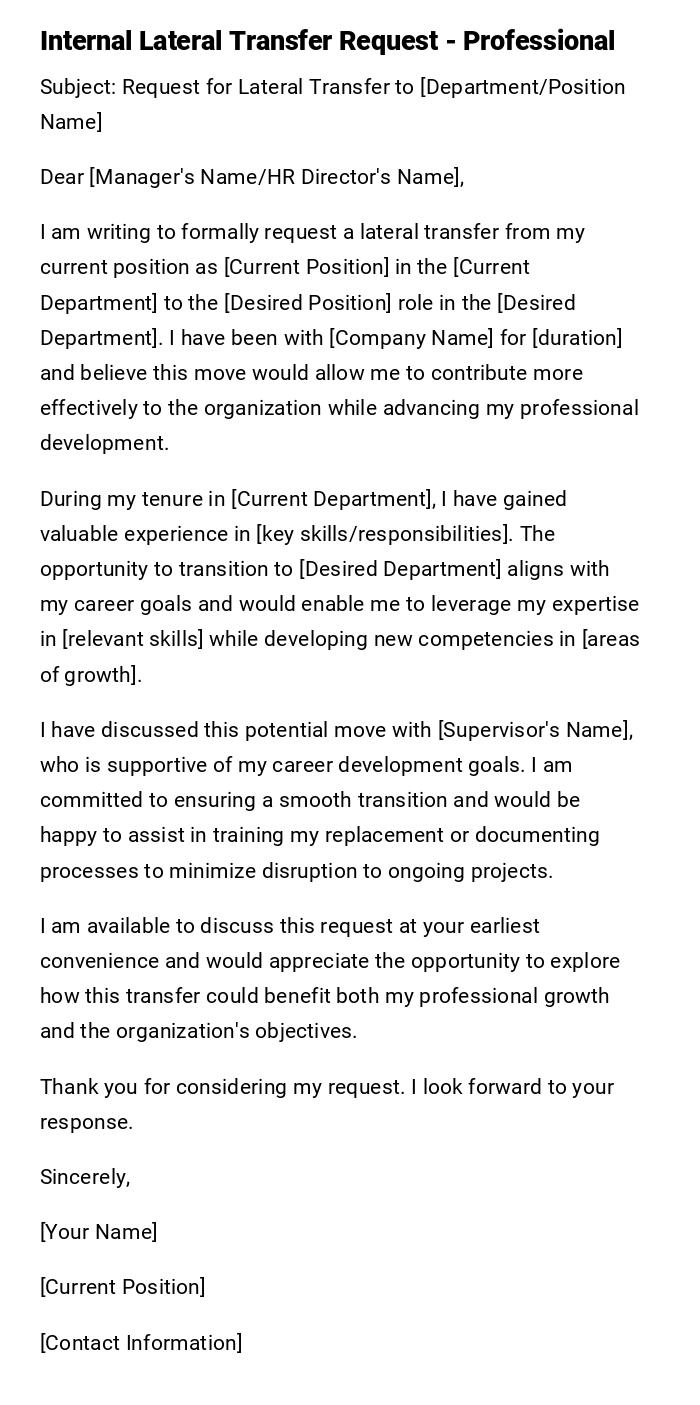
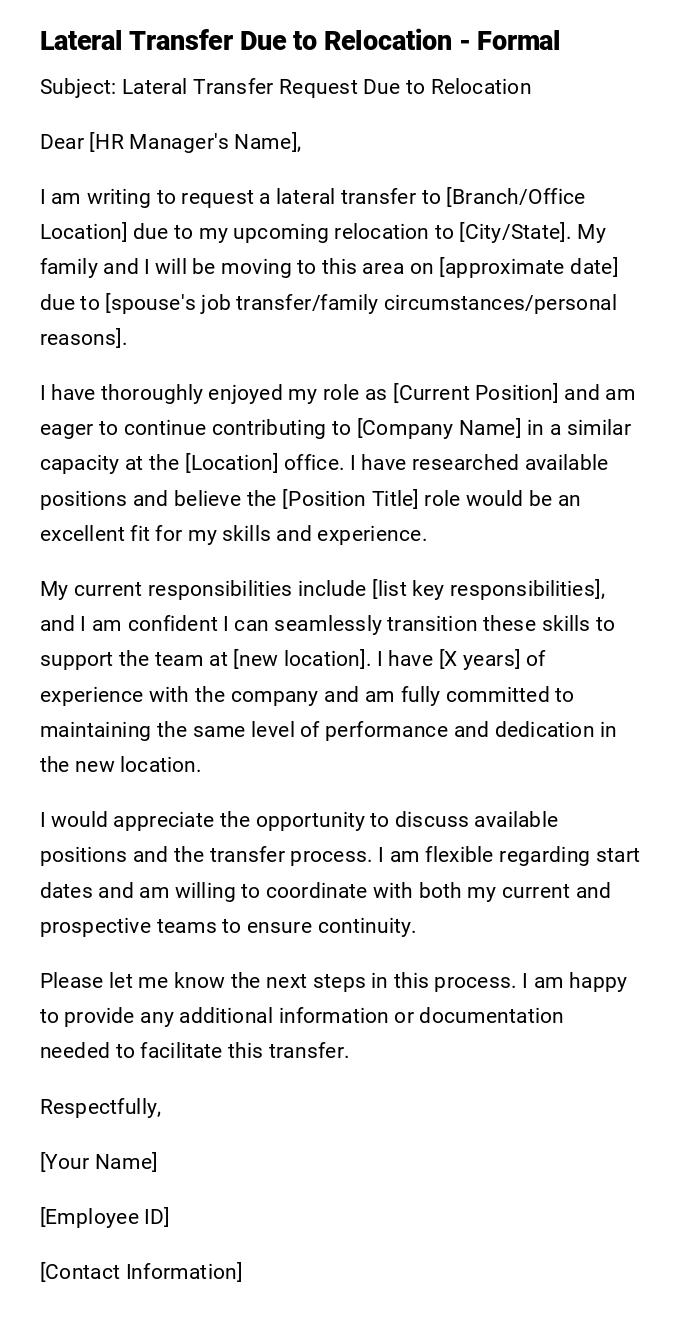
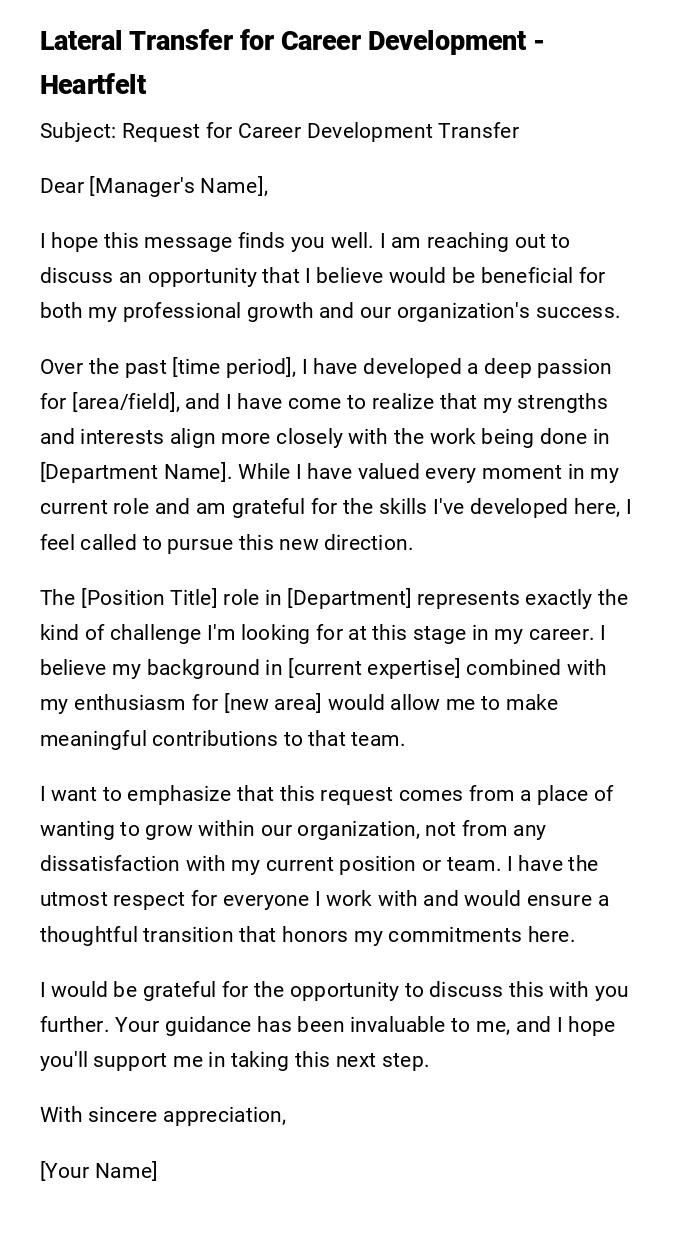
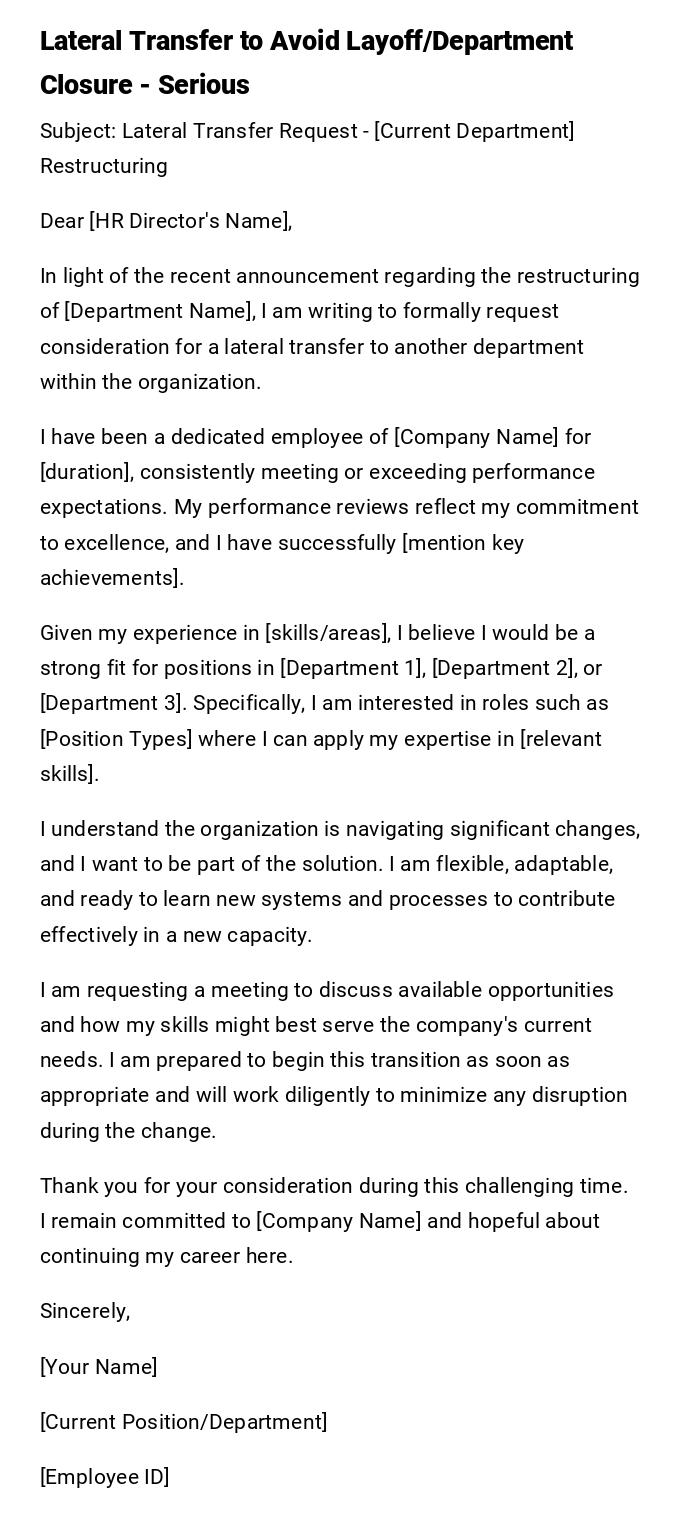
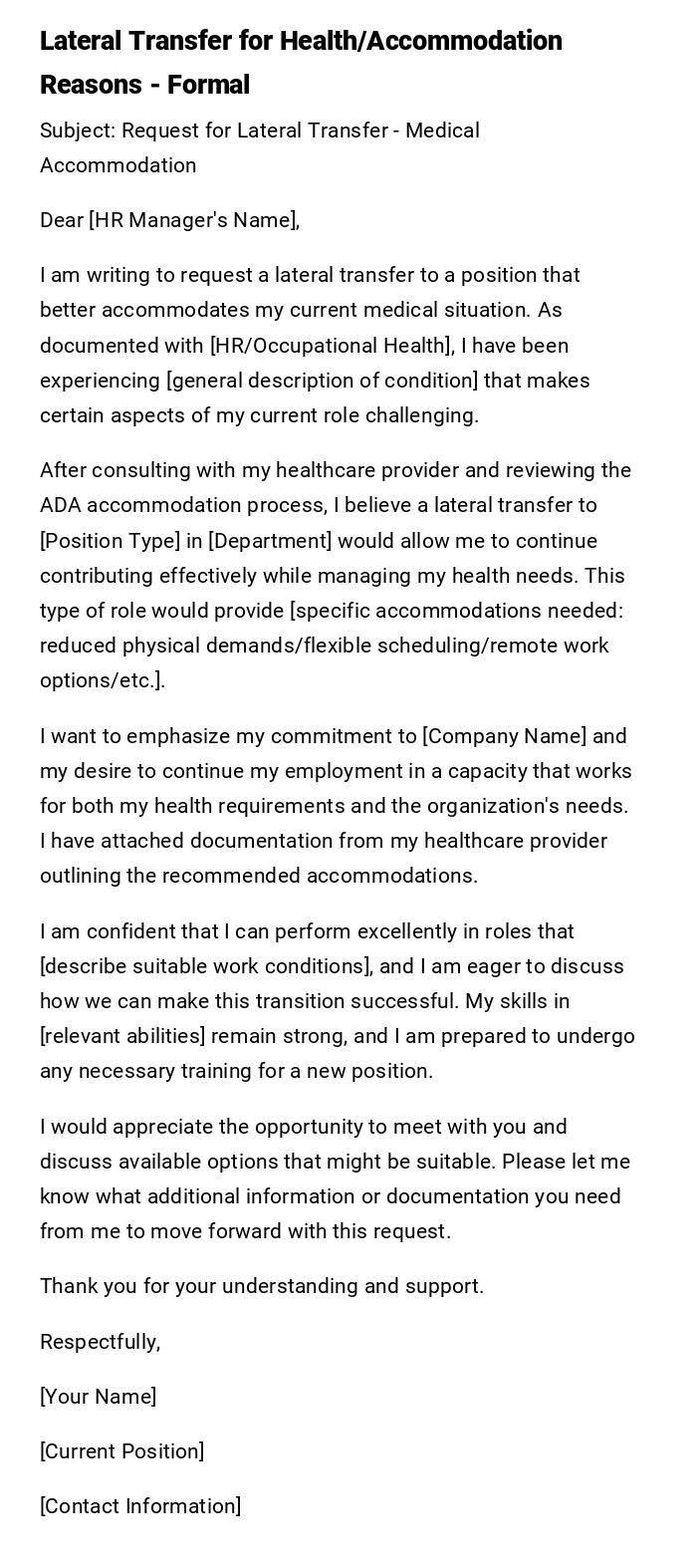
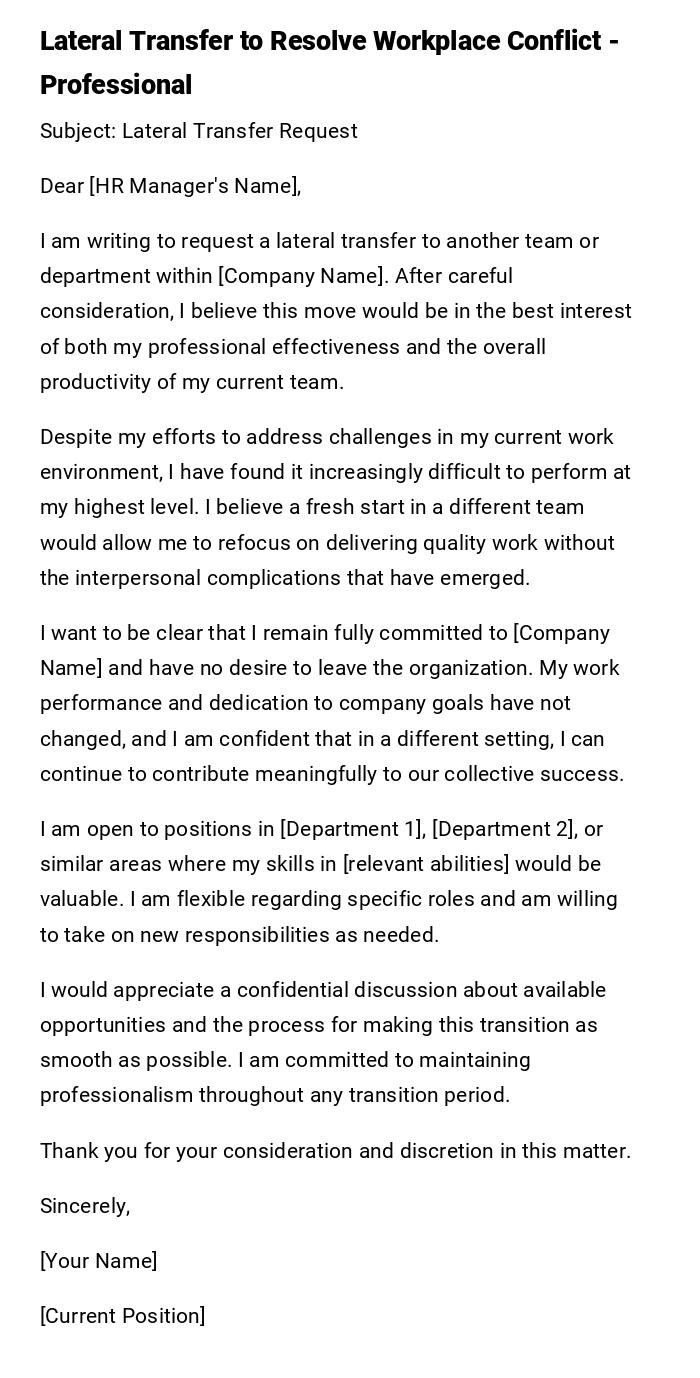
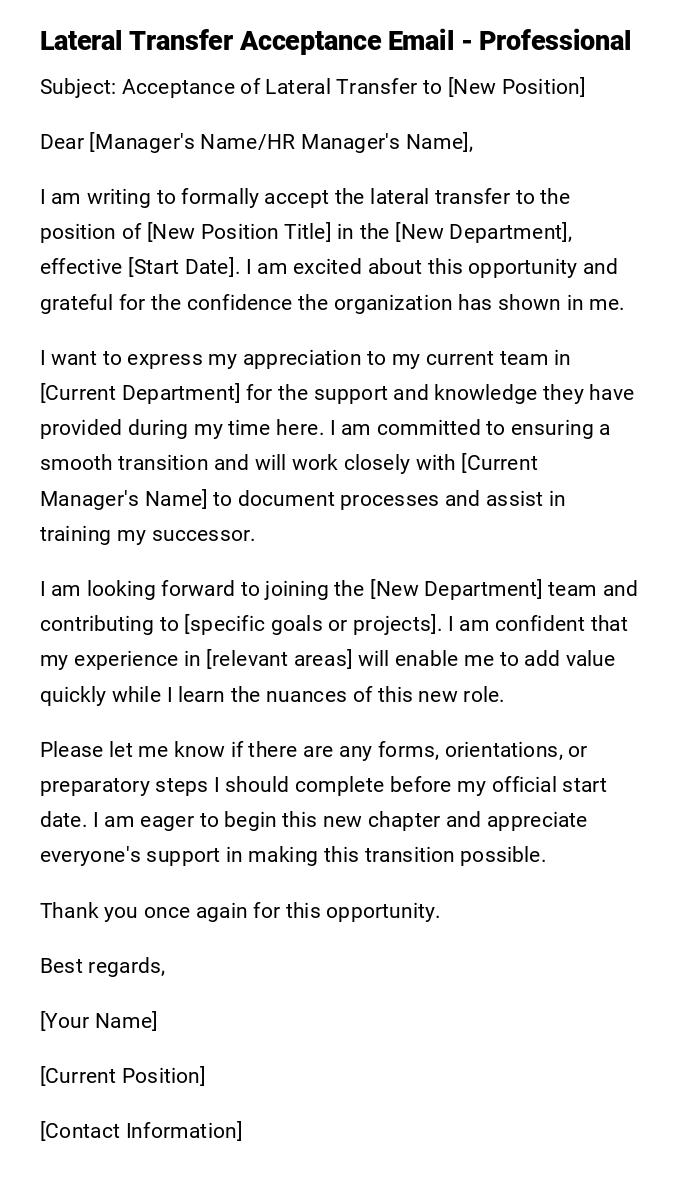
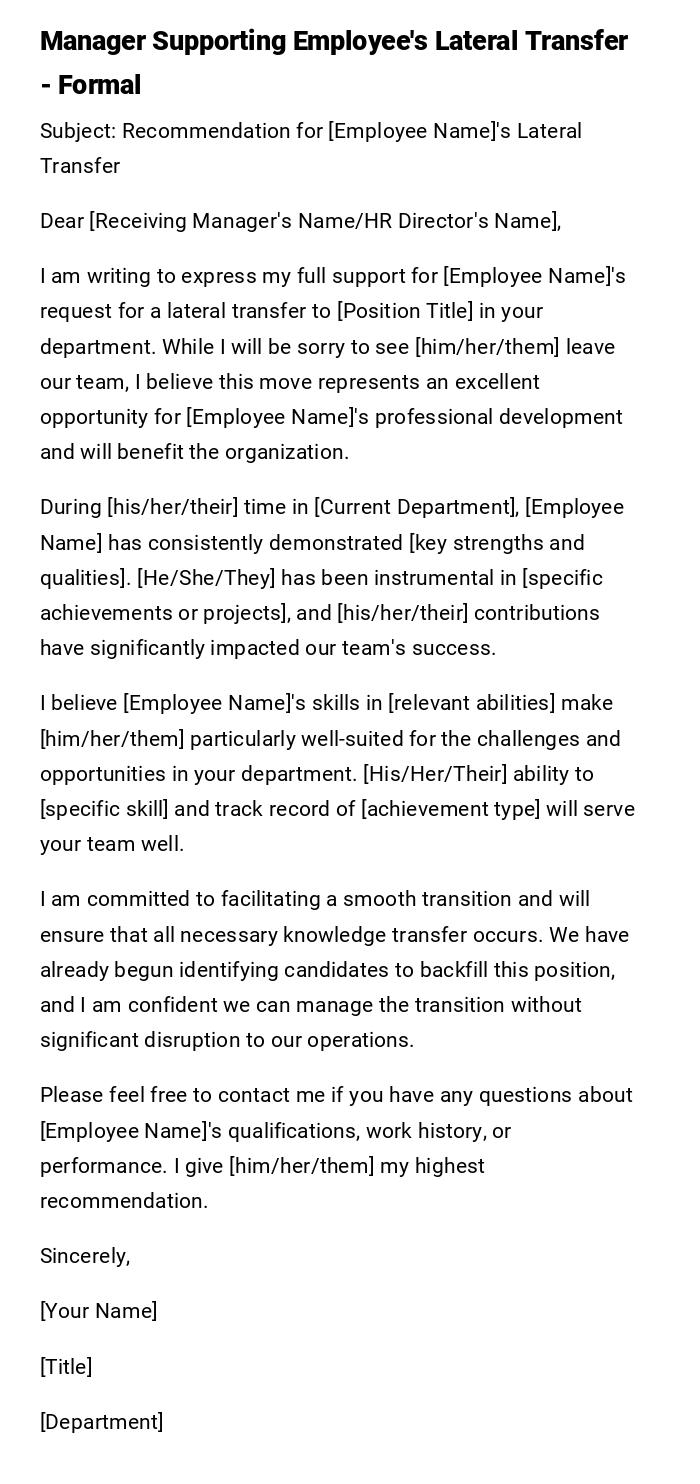

 Download Word Doc
Download Word Doc
 Download PDF
Download PDF